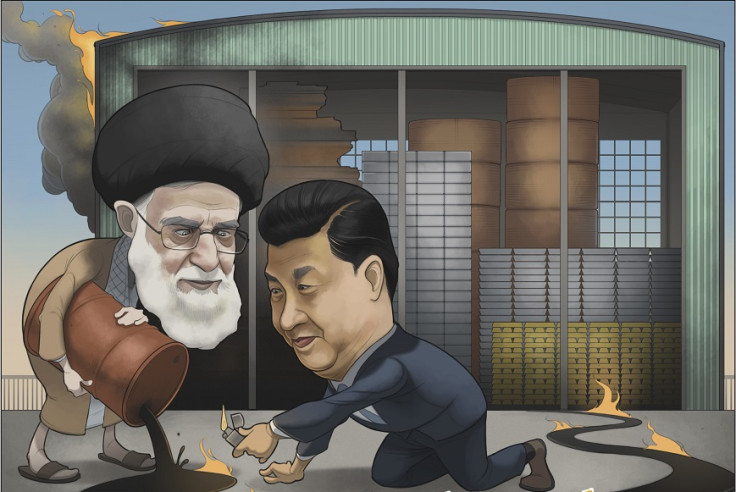In focus: How China and Iran are triggering investor alarm

Investors fled from commodities this week as China and Iran worked black magic on gold and oil sending them plunging in value.
The commodities complex hit a ten year low; gold tumbled to a more than five-year low of $1,080.00 a troy ounce earlier in the week amid concerns over a slowdown in demand from China.
Oil dropped below the $50-level for the first time since early April, weighed by concerns over a resumption of Iranian oil exports adding to a global supply glut.
Iran is expected to pump an extra one million barrels a day as a result of the deal, which has been driving prices down by around 15% in last few weeks. This has interrupted any stabilising of oil prices following the plunge of last year.
Opec which usually steps in and alters supply, appears to be powerless to moderate in this instance.
Iran's contribution to global energy supply is good news for consumers, where in the UK we are already seeing second round of price cuts at pumps, championed on the forecourts of Morrisons and Asda.
China's economic trials are also reverberating across commodities: along with India, China has a vast appetite for gold but its slowing economy has deterred some from making conspicuous luxury buys.
The latest drop in the gold price was also affected by Chinese investors selling a lot of gold and the news that its gold reserves are 57% higher than they were six years ago.
A staggering $800bn has flowed out of China's equity markets in the past year, according to analysts from Lombard Street Research. Some $225bn of capital outflows in the second quarter, according to Goldman Sachs.
In the past couple of weeks Chinese government has done everything in its power to control a $3tn stock markets route by artificially pumping up shares in big blue chips, while preventing people selling falling stocks.
'Rescue leverage with leverage'
The Chinese tactic to "rescue leverage with leverage" is now seeing mainland banks allegedly devising innovative but opaque methods to lend to companies so they can buy their own shares, which appears to be yet another backdoor method to prop up a bursting stock market bubble, and one that comes straight from the Japan 1990's playbook.
Analysts from Rabobank said: "For those that believe asset prices and economic cycles are driven largely by credit ebbs and flows, that policy shift back towards more lending would not be a surprise, if true, as the only way that an economy can reduce leverage and maintain rapid growth is if it increases exports at the same time.
"China is not able to do that against a weak global demand backdrop, and with a de facto currency peg to a rising USD as we head towards the October IMF decision on Special Drawing Rights status. More importantly, one can make a strong case that exactly the same 'Rescue Leverage with Leverage' strategy is playing out across the global economy for the same reason."
The Chinese government is now pushing new loans through the state banking system. These reached $205bn in June, up from $145bn in May, while $113bn in bonds have been issued by at local government level.
What is required is a painful overhaul of China's "free" market system. The country's emergent middle-class army of 900,000 individual investors has been fuelled by margin loans, which allowed investors to borrow using existing securities as collateral, and the massive shadow banking system of unregulated financial intermediaries of all shapes and sizes.
The scramble away from real estate has also helped inflate Chinese equities. This has caused some analysts to say the real estate bubble has in fact been transferred to an equities bubble.
China has built homes and infrastructure at a rate hitherto unseen, in order to meet the demand for homes of potentially 1.4 billion people, following government reforms to allow people to privately own property, which came into effect in 2004. This paved the way for the current economic boom (and bust).
Chinese jobs keep growing
The one thing China continues to legitimately create – its greatest commodity – is jobs. China's National Bureau of Statistics published the results of a 31-city labour market survey on 20 July, showing that in the first six months this year, China created 7.18 million new urban jobs, compared to an annual target of 10 million.
Apparently growth is not dragging job creation with it, because of an accelerated transition to services.
Brian Jackson, China Economist, IHS Global Insight said: "Labor market stability is the paramount economic indicator for central leadership in China, and job market creation is one of the key targets from a menu of economic goals each year.
"In 2014, new job creation was one of the only macroeconomic targets that was exceeded.
"Achieving a majority of this year's target during the first half will relieve some pressure on China's central leadership to pump growth in the second half, which is expected to slow as contributions from the financial sector wane following the recent stock market rout."
© Copyright IBTimes 2024. All rights reserved.






